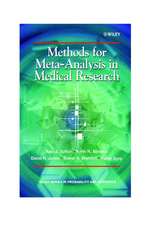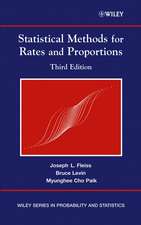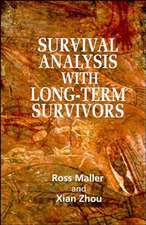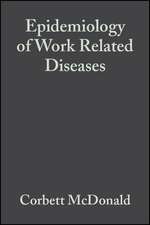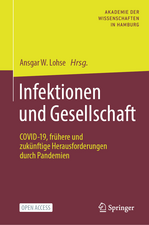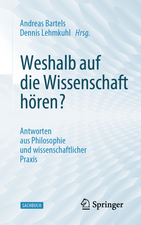Applying the Rasch Model: Fundamental Measurement in the Human Sciences
Autor Trevor Bond, Zi Yan, Moritz Heeneen Limba Engleză Hardback – 20 iul 2020
Highlights of the new edition include:
- More learning tools to strengthen readers’ understanding including chapter introductions, boldfaced key terms, chapter summaries, activities and suggested readings.
- Greater emphasis on the use of R packages; readers can download the R code from the Routledge website.
- Explores the distinction between numerical values, quantity and units, to understand the measurement and the role of the Rasch logit scale (Chapter 4).
- A new four-option data set from the IASQ (Instrumental Attitude towards Self-assessment Questionnaire) for the Rating Scale Model (RSM) analysis exemplar (Chapter 6).
- Clarifies the relationship between Rasch measurement, path analysis and SEM, with a host of new examples of Rasch measurement applied across health sciences, education and psychology (Chapter 10).
| Toate formatele și edițiile | Preț | Express |
|---|---|---|
| Paperback (1) | 359.47 lei 22-36 zile | +32.90 lei 6-12 zile |
| Taylor & Francis – 20 iul 2020 | 359.47 lei 22-36 zile | +32.90 lei 6-12 zile |
| Hardback (1) | 883.41 lei 43-57 zile | |
| Taylor & Francis – 20 iul 2020 | 883.41 lei 43-57 zile |
Preț: 883.41 lei
Preț vechi: 1077.33 lei
-18% Nou
Puncte Express: 1325
Preț estimativ în valută:
169.09€ • 183.74$ • 142.13£
169.09€ • 183.74$ • 142.13£
Carte tipărită la comandă
Livrare economică 21 aprilie-05 mai
Preluare comenzi: 021 569.72.76
Specificații
ISBN-13: 9780367141417
ISBN-10: 0367141418
Pagini: 376
Ilustrații: 248
Dimensiuni: 178 x 254 x 25 mm
Greutate: 1.79 kg
Ediția:Nouă
Editura: Taylor & Francis
Colecția Routledge
Locul publicării:Oxford, United Kingdom
ISBN-10: 0367141418
Pagini: 376
Ilustrații: 248
Dimensiuni: 178 x 254 x 25 mm
Greutate: 1.79 kg
Ediția:Nouă
Editura: Taylor & Francis
Colecția Routledge
Locul publicării:Oxford, United Kingdom
Public țintă
Postgraduate, Professional, and UndergraduateCuprins
Foreword
Preface
Notes on This Volume
About the Authors
True Score Theory, Latent Traits, and Item Response Theory
Would You Like an Interval Scale With That?
Model Assumptions and Measurement Requirements
Construct Validity
The Rasch Model and Progress of Science
Back to the Beginning and Back to the End
Summary
Appendix A: Getting Started
Appendix B: Technical Aspects of the Rasch Model
Appendix C: Going All the Way
Glossary
Author Index
Subject Index
Preface
Notes on This Volume
About the Authors
- Why Measurement Is FundamentalChildren Can Construct Measures
Interval Scales v. Ratio Scales: A Conceptual Explanation
Statistics and/or Measurement
Why Fundamental Measurement?
Derived Measures
Conjoint Measurement
The Rasch Model for Measurement
A More Suitable Analogy for Measurement in the Human Sciences
In Conclusion
Summary - Important Principles of Measurement Made ExplicitAn example: "By How Much?"
Moving From Observations to Measures
Summary - Basic Principles of the Rasch ModelThe Pathway Analogy
A Basic Framework for Measurement
The Rasch Model
Summary - Building a Set of Items for MeasurementThe Nature of the Data
Analyzing Dichotomous Data: The BLOT
A Simple Rasch Summary: The Item Pathway
Item Statistics
Item Fit
The Wright Map
Targeting
Comparing Persons and Items
Summary
Extended Understanding
The Problem of Guessing
Difficulty, Ability, and Fit
The Theory–Practice Dialog
Summary - Invariance: A Crucial Property of Scientific MeasurementPerson and Item Invariance
Common-Item Linking
Please Keep in Mind
Anchoring Item Values
Vertical Scaling
Common-Person Linking
Invariance of Person Estimates across Tests: Concurrent Validity
The PRTIII-Pendulum
Common-Person Linking: BLOT & PRTIII
The Theory–Practice Dialog
Measurement Invariance: Where It Really Matters
Failures of Invariance: DIF
Differential Rater Functioning
DIF: Not Just a Problem, but an Opportunity
Summary - Measurement Using Likert ScalesThe Rasch Model for Polytomous Data
Analyzing Rating Scale Data: The Instrumental Attitude towards Self-Assessment Questionnaire
Summary
Extended Understanding
Summary - The Partial Credit Rasch ModelClinical Interview Analysis: A Rasch-Inspired Breakthrough
Scoring Interview Transcripts
Partial Credit Model Results
Interpretation
The Theory–Practice Dialog
Summary
Extended Understanding
Point–Measure Correlations
Fit Statistics
Dimensionality: Primary Components Factor Analysis
Summary - Measuring Facets Beyond Ability and DifficultyA Basic Introduction to the Many-Facets Rasch Model
Why Not Use Interrater Reliability?
Relations Among the Rasch Family of Models
Data Specifications of the Many-Facets Rasch Model
Rating Creativity of Junior Scientists
8.6 Many-Facets Analysis of Eighth-Grade Writing
Summary
Extended Understanding
Rasch Measurement of Facets Beyond Rater Effects
Summary - Making Measures, Setting Standards, and Rasch RegressionCreating a Measure from Existing Data: The RMPFS (Zi Yan, EdUHK)
Method: Data
Physical Fitness Indicators
Data Analysis
Seven Criteria to Investigate the Quality of Physical Fitness Indicators
Results and Discussion
Optimising Response Categories
Influence of Underfitting Persons on the RMPFS
Properties of the RMPFS With Subsamples
Age Dependent or Age Related?
The Final Version of RMPFS
Objective Standard Setting: The OSS Model (Gregory Stone, U Toledo)
Early Definitions
The Objective Standard Setting Models
Objective Standard Setting for Dichotomous Examinations
Objective Standard Setting for Judge-Mediated Examinations
Fair Standards, Not Absolute Values
Rasch Regression (Svetlana Beltyukova, U Toledo)
Predicting Physician Assistant Faculty Intention to Leave Academia
Rasch Regression Using the Anchored Formulation
Rasch Regression: Alternative Approaches
Discussion
Summary - The Rasch Model Applied Across the Human SciencesRasch Measurement in Health Sciences
Optimising an Existing Instrument: The NIHSS and a Central Role for PCA
Creating a Short Form of an Existing Instrument: The FSQ
FSQ-SF
Theory Guides Assessment Revisions: The PEP–S8
Applications in Education and Psychology
Rasch Measures as Grist for the Analytical Mill
Rasch Gain Calculations: Racking and Stacking
Rasch Learning Gain Calculations: The CCI
Racking and Stacking
Stacking Can Be Enough: UPAM
Sub- Test Structure Informs Scoring Models
Applications to Classroom Testing
Can Rasch Measurement Help S.S. Stevens?
Using Rasch Measures with Path Analysis (SEM Framework)
Rasch Person Measures Used in a Partial Least Squares (PLS) Framework
And Those Rasch Measurement SEs?
Can We Really Combine SEM and Rasch Models?
Conclusion
Summary - Rasch Modeling Applied: Rating Scale DesignRating Scale Design
Category Frequencies and Average Measures
Thresholds and Category Fit
Revising a Rating Scale
An Example
Guidelines for Collapsing Categories
Problems With Negatively Worded Items
The Invariance of the Measures across Groups
Summary - Rasch Model Requirements: Model Fit and UnidimensionalityThe Data, the Model, and the Residuals
Residuals
Fit Statistics
Expectations of Variation
Fit, Misfit, and Interpretation
Fit: Issues for Resolution
Principal Components Analysis of Rasch Residuals: The BLOT as an Exemplar
One Dimension, Two Dimensions, Three Dimensions, More?
Extended Understanding
A Further Investigation: BLOT and PRTIII
Summary - A Synthetic Overview
True Score Theory, Latent Traits, and Item Response Theory
Would You Like an Interval Scale With That?
Model Assumptions and Measurement Requirements
Construct Validity
The Rasch Model and Progress of Science
Back to the Beginning and Back to the End
Summary
Appendix A: Getting Started
Appendix B: Technical Aspects of the Rasch Model
Appendix C: Going All the Way
Glossary
Author Index
Subject Index
Notă biografică
Trevor G. Bond is currently Adjunct Professor at the College of Arts, Society and Education at James Cook University, Australia.
Zi Yan is Associate Professor in the Department of Curriculum and Instruction at the Education University of Hong Kong.
Moritz Heene is Full Professor of Learning Sciences Research Methodologies (i.e., Quantitative Methods) at the Ludwig-Maximilians-Universität München, Germany.
Zi Yan is Associate Professor in the Department of Curriculum and Instruction at the Education University of Hong Kong.
Moritz Heene is Full Professor of Learning Sciences Research Methodologies (i.e., Quantitative Methods) at the Ludwig-Maximilians-Universität München, Germany.
Recenzii
From a previous edition:
"The tiresome debate about Rasch vs. IRT is over -- if you want to construct valid measurements from uncertain observations you need to understand and learn how to use Rasch measurement. Bond and Fox is your huckleberry -- read it and get to work!" – Robert W. Massof, Johns Hopkins University School of Medicine, USA
"Bond & Fox's book is a must read for anyone interested in measurement. This book is my go-to for introducing graduate students to the Rasch model." – Kelly D. Bradley, University of Kentucky, USA
"The authors have successfully made sophisticated measurement theory into feasible practice for practitioners by providing clear and intuitive explanations, numerous examples, and nice computer outputs. It is a textbook that I have used and will continue to use in the future." – Wen Chung Wang, Hong Kong Institute of Education, Hong Kong
"Bond and Fox provide a clear and accessible introduction to the Rasch model… I always recommend their book when a student or colleagues asks me to explain Rasch measurement theory." – George Engelhard, Jr., The University of Georgia, USA
"The Rasch model represents modern measurement theory at its best … Rasch models are used around the world to create psychometrically defensible scales and tests. Bond and Fox provide an accessible introduction to the Rasch model that describes the logic and essential importance of fundamental measurement in the human sciences." – George Engelhard, Jr., The University of Georgia, USA
From a previous edition:
"The tiresome debate about Rasch vs. IRT is over – if you want to construct valid measurements from uncertain observations you need to understand and learn how to use Rasch measurement. Bond and Fox is your huckleberry – read it and get to work!" – Robert W. Massof, Johns Hopkins University School of Medicine, USA
"Bond & Fox's book is a must read for anyone interested in measurement. This book is my go-to for introducing graduate students to the Rasch model." – Kelly D. Bradley, University of Kentucky, USA
"The authors have successfully made sophisticated measurement theory into feasible practice for practitioners by providing clear and intuitive explanations, numerous examples, and nice computer outputs. It is a textbook that I have used and will continue to use in the future." – Wen Chung Wang, Hong Kong Institute of Education, Hong Kong
"The Rasch model represents modern measurement theory at its best … Rasch models are used around the world to create psychometrically defensible scales and tests. Bond and Fox provide an accessible introduction to the Rasch model that describes the logic and essential importance of fundamental measurement in the human sciences." – George Engelhard, Jr., The University of Georgia, USA
"The tiresome debate about Rasch vs. IRT is over -- if you want to construct valid measurements from uncertain observations you need to understand and learn how to use Rasch measurement. Bond and Fox is your huckleberry -- read it and get to work!" – Robert W. Massof, Johns Hopkins University School of Medicine, USA
"Bond & Fox's book is a must read for anyone interested in measurement. This book is my go-to for introducing graduate students to the Rasch model." – Kelly D. Bradley, University of Kentucky, USA
"The authors have successfully made sophisticated measurement theory into feasible practice for practitioners by providing clear and intuitive explanations, numerous examples, and nice computer outputs. It is a textbook that I have used and will continue to use in the future." – Wen Chung Wang, Hong Kong Institute of Education, Hong Kong
"Bond and Fox provide a clear and accessible introduction to the Rasch model… I always recommend their book when a student or colleagues asks me to explain Rasch measurement theory." – George Engelhard, Jr., The University of Georgia, USA
"The Rasch model represents modern measurement theory at its best … Rasch models are used around the world to create psychometrically defensible scales and tests. Bond and Fox provide an accessible introduction to the Rasch model that describes the logic and essential importance of fundamental measurement in the human sciences." – George Engelhard, Jr., The University of Georgia, USA
From a previous edition:
"The tiresome debate about Rasch vs. IRT is over – if you want to construct valid measurements from uncertain observations you need to understand and learn how to use Rasch measurement. Bond and Fox is your huckleberry – read it and get to work!" – Robert W. Massof, Johns Hopkins University School of Medicine, USA
"Bond & Fox's book is a must read for anyone interested in measurement. This book is my go-to for introducing graduate students to the Rasch model." – Kelly D. Bradley, University of Kentucky, USA
"The authors have successfully made sophisticated measurement theory into feasible practice for practitioners by providing clear and intuitive explanations, numerous examples, and nice computer outputs. It is a textbook that I have used and will continue to use in the future." – Wen Chung Wang, Hong Kong Institute of Education, Hong Kong
"The Rasch model represents modern measurement theory at its best … Rasch models are used around the world to create psychometrically defensible scales and tests. Bond and Fox provide an accessible introduction to the Rasch model that describes the logic and essential importance of fundamental measurement in the human sciences." – George Engelhard, Jr., The University of Georgia, USA
Descriere
Recognised as the most influential publication in the field, ARM facilitates deep understanding of the Rasch model and its practical applications. The authors review the crucial properties of the model and demonstrate its use with examples across the human sciences.








